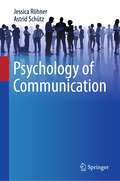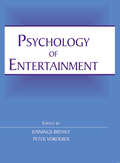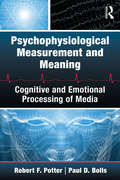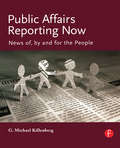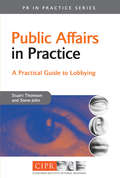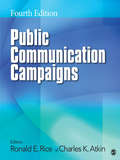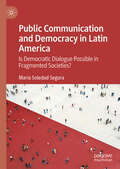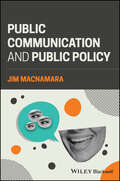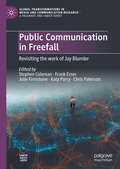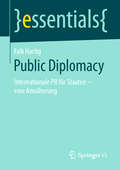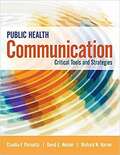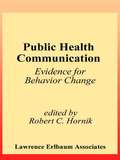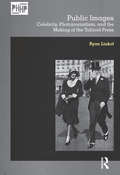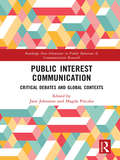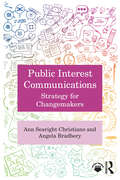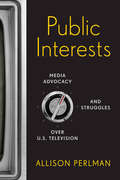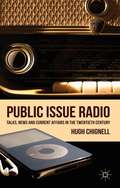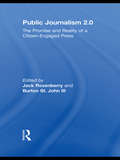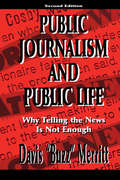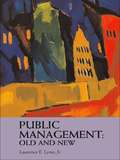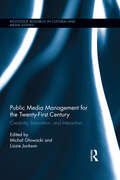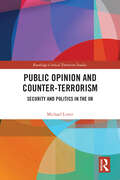- Table View
- List View
Psychological Warfare in the Arab-Israeli Conflict
by Ron SchleiferThe first study to examine psychological warfare in the context of the Arab-Israeli conflict, this book presents a rational analysis of the Arab and Israeli struggles to gain the world's sympathy and support, tracing these struggles from the British Mandate to the more recent HAMAS abduction of IDF soldier Gilad Shalit.
Psychologie des Geschichtenerzählens
by Tobias C. BreinerIn diesem Buch geht es um die Psychologie guter Geschichten und deren Handlungsfiguren. Es beantwortet Fragen wie:Warum rühren uns manche Filme zu Tränen und andere lassen uns kalt?Warum fesseln uns manche Romane so, dass wir bis tief in die Nacht weiterlesen? Warum quälen wir uns dagegen durch manche Pflichtlektüre hindurch?Warum zocken wir manches Adventure-Game bis zum letzten Level während wir bei anderen schnell die Lust verlieren? Das Werk ist für all diejenigen verfasst, die sich in irgendeiner Weise mit der Erzeugung und Bewertung von Handlungen befassen. Sowohl Charakter- und Game-Designer profitieren durch neue archetypische Modelle und Psychologen können mit der hier präsentierten dodekazyklischen Heldenreise innovative therapeutische Methoden entwickeln. Roman- und Drehbuchautoren bekommen eine Blaupause für erfolgsversprechende Geschichten, die sich auch auf das Interactive Storytelling übertragen lässt und Regisseure sowie Film-, Computerspiel- und Literaturkritiker erhalten durch den Inhalt des Werkes gezielte Bewertungskriterien.
Psychology of Communication
by Jessica Röhner Astrid SchützThis successful textbook on the psychology of communication explains - here in English for the first time - how human communication works in a very understandable way. It begins with the explanation of central terms and the explanation of known communication models (e.g. the models according to Schulz von Thun, Watzlawick, Hargie and colleagues), then describes means of non-verbal and verbal communication and ends with a clear and structured summary of communication forms. Concrete fields of application, stumbling blocks (e.g. intercultural differences in communication), practical examples and digressions in the book round off what has been read and consolidate what has been learned. In addition, free learning materials are available on the Internet with which readers can test their knowledge acquisition.
Psychology of Entertainment: The Psychology Of Its Appeal (Routledge Communication Series)
by Jennings Bryant Peter VordererAs entertainment becomes a trillion-dollar-a-year industry worldwide, as our modern era increasingly lives up to its label of the "entertainment age," and as economists begin to recognize that entertainment has become the driving force of the new world economy, it is safe to say that scholars are beginning to take entertainment seriously. The scholarly spin on entertainment has been manifested in traditional ways, as well as innovative ones. Representing the current state of theory and research, Psychology of Entertainment promises to be the most comprehensive and up-to-date volume on entertainment. It serves to define the new area of study and provides a theoretical spin for future work in the area.Divided into three basic parts, this book:*addresses the fundamental mechanisms and processes involved in orienting to and selecting entertainment fare, as well as receiving and processing it;*explores the mechanisms and processes by which we are entertained by the media messages we select and receive; and*provides an opportunity for the application of well-established as well as emerging psychological and psychobiological theories to be applied to the study of entertainment in ways that seldom have been utilized previously.Psychology of Entertainment will appeal to scholars, researchers, and graduate students in media studies and mass communication, psychology, marketing, and other areas contributing to the entertainment studies area.
Psychophysiological Measurement and Meaning: Cognitive and Emotional Processing of Media (Routledge Communication Series)
by Robert F. Potter Paul BollsThis research volume serves as a comprehensive resource for psychophysiological research on media responses. It addresses the theoretical underpinnings, methodological techniques, and most recent research in this area. It goes beyond current volumes by placing the research techniques within a context of communication processes and effects as a field, and demonstrating how the real-time measurement of physiological responses enhances and complements more traditional measures of psychological effects from media. This volume introduces readers to the theoretical assumptions of psychophysiology as well as the operational details of collecting psychophysiological data. In addition to discussing specific measures, it includes brief reviews of recent experiments that have used psychophysiological measures to study how the brain processes media. It will serve as a valuable reference for media researchers utilizing these methodologies, or for other researchers needing to understand the theories, history, and methods of psychophysiological research.
Psychotherapy after Brain Injury
by Pamela KlonoffThis book presents hands-on tools for addressing the multiple ways that brain injury can affect psychological functioning and well-being. The author is a leader in the field who translates her extensive clinical experience into clear-cut yet flexible guidelines that therapists can adapt for different challenges and settings. With a focus on facilitating awareness, coping, competence, adjustment, and community reintegration, the book features helpful case examples and reproducible handouts and forms. It shows how to weave together individual psychotherapy, cognitive retraining, group and family work, psychoeducation, and life skills training, and how to build and maintain a collaborative therapeutic relationship.
Public Affairs Reporting Now: News of, by and for the People
by George Michael KillenbergEveryday life, no whether the issues or events arise next-door or a continent away, raises questions and concerns that the public counts on journalists to answer and, more important, confront. More than ever before, we all rely on the news media for warnings, explanations and insights. The profession - and society - cannot afford lazy, inept, uncommitted journalists. Today's reporters must learn how to cover public affairs intelligently and thoroughly. First you must learn about the institutions and people who influence the news; understanding how a legislative conference committee functions or how a trial is conducted remain important pre-requisites. But it is not enough merely to know how to report. Journalists must also understand how they see, define and influence the news.Don't be fooled by the daily dose of fluffy stories about fads, fashions or fetishes. People love to revel in celebrity gossip or fantasize about extreme makeovers. But Donald Trump's love life or the South Beach Diet don't satisfy when people worry about a home invasion in their neighborhood or a rezoning proposal to bring a Wal-Mart super center to town or a Department of Education report that their child's school scored bottom-most in reading achievement.Public Affairs Reporting Now is intended to teach you the best practices and give you the best advice for covering what's generically known as "public affairs reporting.? It's a term that's neither inspiring nor precise, but it's long been a convenient way of describing the kind of news coverage that keeps people informed as citizens and keeps our institutions, public and private, focused on the public good.
Public Affairs in Practice: A Practical Guide to Lobbying (PR In Practice)
by Stuart Thomson Steve JohnPublic Affairs in Practice explains how public affairs (PA) is now much more than just political lobbying. Modern PA includes working with other policy-making bodies, such as regulators, commercial organizations and other interested parties.This is the first book to examine the methods PA professionals use to make an impact. It takes each area of the industry in turn and looks at the tools involved in delivering a PA programme. It also highlights the potential benefits of public affairs, such as protecting an organization from perceived threats of new regulation; identifying new market opportunities; and raising the profile of an organization. Case studies and tips from industry professionals make this a practical "how to" guide for practitioners at all levels and students.Importantly, the authors consider not only established markets the US, UK and Western Europe but also the opportunities presented to companies from these countries by the EU accession states and China, where there are currently very few PA professionals.Finally, there is a discussion of future trends and developments in PA.
Public Communication Campaigns
by Ronald E. Rice Charles K. AtkinIn this fully revised and expanded Fourth Edition, Ronald E. Rice and Charles K. Atkin provide readers with a comprehensive, up-to-date look into the field of public communication campaigns. Updated to reflect the latest theories and research, this text extends coverage to new areas, including sun protection, organ donation, human rights, social norms, corporate social responsibility, condom use, ocean sustainability, fear messages, and digital games. Classic chapters include updates on topics such as campaign history, theoretical foundations, formative evaluation, systems approaches, input-output persuasion matrix, design and evaluation, meta-analysis, and sense-making methodology.
Public Communication and Democracy in Latin America : Is Democratic Dialogue Possible in Fragmented Societies?
by María Soledad SeguraThe book examines alternatives proposed and implemented by governments, civil society organizations, social movements and companies in Latin America to democratize public communication and overcome its current problems, such as the dissemination of alternative facts and fake news, anti-scientific discourse, harassing, discriminatory and hate speech, anti-human rights and anti-democracy discourses, and the contempt for political correctness. Drawing on theoretical approaches from media and communication, political studies and sociology, the book identifies strengths and weaknesses of the strategies for promoting democratic dialogue in Latin America and globally.
Public Communication and Public Policy: Reviving Democracy by Recalibrating Public Communication
by Jim MacnamaraAn invaluable resource for shaping policies that resonate with the public and benefit democratic practices Democracy may be widespread, but its vitality is under siege. Public trust in governments and institutions has eroded to critical levels, with many democracies failing to include citizens in meaningful consultation, engagement, and participation. Public Communication and Public Policy: Reviving Democracy addresses this urgent need, exposing how one-way communication practices perpetuate disengagement and hinder policy effectiveness. Drawing on research across three continents, author Jim Macnamara dissects policy frameworks and government communication guidelines to uncover systemic shortcomings and offer actionable solutions. Combining critical literature reviews, practitioner interviews, and real-world case studies, Public Communication and Public Policy delivers detailed recommendations to reform public communication—challenging conventional approaches and advocating for recalibrated consultation and citizen participation to rebuild trust and reinvigorate democratic processes. A timely, solutions-focused analysis of democratic challenges, Public Communication and Public Policy Analyzes 16 widely used policy models to reveal critical gaps in consultation and engagement practices Provides detailed strategies to enhance public communication, consultation, and stakeholder participation Introduces groundbreaking frameworks such as the IP-IT model of communication Examines key policy failures such as Robodebt (Australia) and Post Office Horizon (UK) Bridges communication theory, public policy studies, and political science Public Communication and Public Policy: Reviving Democracy by Recalibrating Consultation, Engagement, Participation, and Government Communication is a must-read for academics, students, and professionals in public communication, strategic communication, and public policy. It is particularly relevant for policymakers, advisers, and government communication practitioners aiming to create inclusive, effective, and trust-building policies.
Public Communication in Freefall: Revisiting the work of Jay Blumler (Global Transformations in Media and Communication Research - A Palgrave and IAMCR Series)
by Stephen Coleman Frank Esser Katy Parry Julie Firmstone Chris PatersonThis book addresses key challenges facing global political communication at a time in which transformations in political practice, media ecology and cultural expectations both threaten traditional democratic norms and point to potential new ways of enacting political democracy. Drawing upon the outstanding theoretical insights of Jay Blumler to our understanding of the norms and practices of political communication, but also critically interrogating and updating them where appropriate, the volume asks timely questions about what publicness and democracy mean in the 2020s. Many people are talking and writing about the crisis of political democracy, fewer are talking about the role of the media in relation to that crisis. While many scholars have responded in an ad hoc way to the various crises of populism, polarisation, mis and disinformation, this book shows how Jay Blumler’s scholarship provides us with the tools and framework to research and understand the changing communication environment systemically and rigorously. The book demonstrates the applicability and relevance of Blumler’s work in explicating the current crisis of communication and the need for fresh and radical thinking in tackling it. The book's breadth and depth of chapters from a broad range of scholars from the East and West, ranging from long-standing contributors to the field to those in the early stages of their career, combine to produce a thoughtful and provocative invitation to reflect upon the concept of a ‘crisis of public communication’. We expect this book to become a major source for political communication students and scholars.
Public Diplomacy: The Rise Of Confucius Institutes (essentials)
by Falk HartigDiese essential führt kompakt in das Konzept der Public Diplomacy ein. Public Diplomacy wird international in Wissenschaft und Praxis umfassend debattiert und praktiziert, in Deutschland findet der Begriff bisher allerdings nur wenig Beachtung. Es erläutert die Hintergründe, skizziert Akteure, Instrumente und Zielgruppen sowie ähnliche Begriffe. Zudem wirft das essential Schlaglichter auf bisherige Forschungslücken und leitet Möglichkeiten für weitere Forschungen ab, die sowohl für Wissenschaft und Praxis relevant sind.
Public Health Communication Critical Tools and Strategies
by Claudia Parvanta Richard N. Harner David E. NelsonDesigned for master’s level study, Public Health Communication: Critical Tools and Strategies for Advancing Public Health will prepare new graduates for any entry level position in public health policy/advocacy, health communication, health promotion, social marketing, or community health education. Filled with practical examples, the book is also a valuable resource for those preparing for the CPH or CHES exams. Students will learn core concepts for planning a communication framework as well key strategies for educating the public about health issues including understanding and reporting science, communicating for policy and advocacy, and health literacy and numeracy. The book thoroughly explores classic theories of persuasion in communication such as Extended Parallel Process Model, Inoculation, Sensation Value, and Cognitive Value. The most current forms of digital/multimedia/interactive channels of communication are examined. The last section of the book looks at some special contexts in health communication, such as patient-provider communication as well as risk/emergency communication.
Public Health Communication: Evidence for Behavior Change (Routledge Communication Series)
by Robert C. HornikThis volume argues the case that public health communication has affected health behavior. It brings together 16 studies of large-scale communication in a variety of substantive health areas--tobacco, drugs, AIDS, family planning, heart disease, childhood disease, highway safety--prepared by the authors who did the original research. These studies show important effects and illustrate the central conditions for success. The book also includes complementary analytic chapters which provide a meta-analysis of published results, some approaches to developing communication interventions, and alternative methods for evaluation of public health communication projects. Including studies based on communication programs in the United States, as well as projects done elsewhere in the world, including Europe, Africa, Asia and Latin America, this book: *offers a broad presentation of the alternative research designs that have been used to evaluate public health communication programs; *includes a great range of approaches from field experiments and natural experiments to simple before-after and complex time series designs, using data gathered from individuals and from archives; and *utilizes an innovative perspective on how to exercise public health communication from a leading and thoughtful practitioner. As such, it is required reading for scholars, students, practitioners, and policymakers in public health, health communication, health psychology, and related areas.
Public Images: Celebrity, Photojournalism, and the Making of the Tabloid Press (Photography, History: History, Photography)
by Ryan LinkofThe stolen snapshot is a staple of the modern tabloid press, as ubiquitous as it is notorious. The first in-depth history of British tabloid photojournalism, this book explores the origin of the unauthorised celebrity photograph in the early 20th century, tracing its rise in the 1900s through to the first legal trial concerning the right to privacy from photographers shortly after the Second World War. Packed with case studies from the glamorous to the infamous, the book argues that the candid snap was a tabloid innovation that drew its power from Britain's unique class tensions. Used by papers such as the Daily Mirror and Daily Sketch as a vehicle of mass communication, this new form of image played an important and often overlooked role in constructing the idea of the press photographer as a documentary eyewitness. From Edward VIII and Wallis Simpson to aristocratic debutantes Lady Diana Cooper and Margaret Whigham, the rage of the social elite at being pictured so intimately without permission was matched only by the fascination of working class readers, while the relationship of the British press to social, economic and political power was changed forever.Initially pioneered in the metropole, tabloid-style photojournalism soon penetrated the journalistic culture of most of the globe. This in-depth account of its social and cultural history is an invaluable source of new research for historians of photography, journalism, visual culture, media and celebrity studies.
Public Interest Communication: Critical Debates and Global Contexts (Routledge New Directions In Public Relations And Communication Research Ser.)
by Jane Johnston Magda PieczkaCommunication has become the technology of public interest, demanding a re-examination of the key concept of public in both public relations and communication theory. This book defines a new concept of public interest communication, combining the conflict, negotiation and adaptation inherent in public interest, with a critical approach to communication management and public relations. Combining conceptual discussions about public theories of language with the tension between the public and private interests for public relations professionals, the book uses case studies to explore the negotiation of conflicting interests and the construction of the public interest within systems of governance at local, national and international levels. Public interest communication is identified within social and cultural contexts that resonate globally – health, community, media and the environment - each representing interest conflicts within the changing global environment. Addressing the forces of fragmentation, inequality and individualisation that characterize the modern world, this thought-provoking volume will be of great interest to researchers and advanced students of communication, public relations, environmental communication, public communication, and public policy.
Public Interest Communications: Strategy for Changemakers
by Ann Searight Christiano Angela BradberyWritten by two practitioners with deep professional experience, this book introduces readers to public interest communications, which takes an evidence-based approach to using strategic communications to drive positive social change.Each chapter includes accessible, applicable insights, exercises and real-world examples undergirded by theories and research from a range of academic disciplines: social and cognitive science, communications, systems thinking and human-centered design. The authors provide step-by-step frameworks for practicing public interest communications and illustrate each framework with multiple perspectives through practitioner interviews. Through a focus on fairness and ethics, the book helps readers acquire the mindset of a public interest communicator.This book is an ideal resource for students in strategic communications, health and environmental communications, public relations, journalism, social entrepreneurship, political science and advertising, and in public interest communication courses specifically, who wish to promote lasting change on issues that advance the greater good.Accompanying online materials include worksheets and links to further resources such as videos and podcasts. Please visit www.routledge.com/9781032531915.
Public Interests: Media Advocacy and Struggles over U.S. Television
by Allison PerlmanNearly as soon as television began to enter American homes in the late 1940s, social activists recognized that it was a powerful tool for shaping the nation's views. By targeting broadcast regulations and laws, both liberal and conservative activist groups have sought to influence what America sees on the small screen. Public Interests describes the impressive battles that these media activists fought and charts how they tried to change the face of American television. Allison Perlman looks behind the scenes to track the strategies employed by several key groups of media reformers, from civil rights organizations like the NAACP to conservative groups like the Parents Television Council. While some of these campaigns were designed to improve the representation of certain marginalized groups in television programming, as Perlman reveals, they all strove for more systemic reforms, from early efforts to create educational channels to more recent attempts to preserve a space for Spanish-language broadcasting. Public Interests fills in a key piece of the history of American social reform movements, revealing pressure groups' deep investments in influencing both television programming and broadcasting policy. Vividly illustrating the resilience, flexibility, and diversity of media activist campaigns from the 1950s onward, the book offers valuable lessons that can be applied to current battles over the airwaves.
Public Issue Radio: Talks, News and Current Affairs in the Twentieth Century
by Hugh ChignellBased on original and previously unseen written and sound archives and interviews with former and current radio producers and presenters, Public Issue Radio addresses the controversial question of the political leanings of current affairs programmes, and asks if Analysis became an early platform for both Thatcherite and Blairite ideas.
Public Journalism 2.0: The Promise and Reality of a Citizen Engaged Press
by Jack Rosenberry Burton St JohnWhere does journalism fit in the media landscape of blogs, tweets, Facebook postings, YouTube videos, and literally billions of Web pages? Public Journalism 2.0 examines the ways that civic or public journalism is evolving, especially as audience-created content—sometimes referred to as citizen journalism or participatory journalism—becomes increasingly prominent in contemporary media. As the contributors to this edited volume demonstrate, the mere use of digital technologies is not the fundamental challenge of a new citizen-engaged journalism; rather, a depper understanding of how civic/public journalism can inform citizen-propelled initiatives is required. Through a mix of original research, essays, interviews, and case studies, this collection establishes how public journalism principles and practices offer journalists, scholars, and citizens insights into how digital technology and other contemporary practices can increase civic engagement and improve public life. Each chapter concludes with pedagogical features including: * Theoretical Implications highlighting the main theoretical lessons from each chapter, * Practical Implications applying the chapter's theoretical findings to the practice of citizen-engaged jouranlis, *Reflection Questions prompting the reader to consider how to extend the theory and application of the chapter. blogging and other participatory journalism practices enabled by digital technology are not always in line with the original vision of public journalism, which strives to report news in such a way as to promote civic engagement by its audience. Public Journalism 2.0 seeks to reinvent public journalism for the 21st century and to offer visions of how digital technology can be enlisted to promote civic involvement in the news.
Public Journalism and Public Life: Why Telling the News Is Not Enough
by Davis Buzz" MerrittThe original edition of Public Journalism and Public Life, published in 1995, was the first comprehensive argument in favor of public journalism. Designed to focus the discussion about public journalism both within and outside the profession, the book has accomplished its purpose. In the ensuing years, the debate has continued; dozens of newspapers and thousands of journalists have been experimenting with the philosophy, while others still dispute its legitimacy. This larger second edition further develops the philosophy, responds to the arguments against it, outlines how specific principles can be applied, and explains the importance of public deliberation and the role of values in public journalism. Divided into three sections, it can be used as a supplement to the first edition or as a starting point for those being newly introduced to the ideas that have been the subject of debate within the profession and among those interested and involved in civic life at all levels. Section 1 summarizes two major arguments -- why journalism and public life are inseparably bound in success or failure and why the way journalism operates in the current environment fosters failure more often than success. Section 2 looks at the evolution of the profession's culture, its impact on the author's extensive career, and how he grew to believe that substantive change is needed in journalism. Section 3 deals with the implications of public journalism philosophy -- how it requires the application of additional values to daily work, its evolution in the early years and where its current focus should be, plus various questions about the future of cyberspace.
Public Management: Old and New
by Laurence E. Lynn Jr.Offering much more than a purely theoretical or retrospective view of public management, this exciting text is an invaluable new addition to the field of public management. Putting the American model in perspective, it establishes the historical, theoretical, analytical, practical and future foundations for the comparative study of public management. Taking a boldly integrative approach, Laurence E. Lynn Jr. combines topics of best practice, performance, accountability and rule of law to provide a much-needed umbrella view of the topic. Well-written and illustrated with case study examples, this is one of the most exciting books on public management available today. As such it is an essential read for every student of public management, administration and public policy.
Public Media Management for the Twenty-First Century: Creativity, Innovation, and Interaction (Routledge Research in Cultural and Media Studies)
by Michał Głowacki Lizzie JacksonThis book analyzes the challenges facing public service media management in the face of ongoing technological developments and changing audience behaviors. It connects models, strategies, concepts, and managerial theories with emerging approaches to public media practices through an examination of media services (e.g. blogs, social networks, search engines, content aggregators) and the online performance of traditional public media organizations. Contributors identify the most relevant and useful approaches, those likely to encourage creativity, interaction, and the development of innovative content and services, and discuss how such innovation can underpin the continuation or expansion of public service media in the changing mediascape.
Public Opinion and Counter-Terrorism: Security and Politics in the UK (Routledge Critical Terrorism Studies)
by Michael ListerThis book examines the ways in which the views of the public inhabit the counter-terrorism policy space, with a focus on the UK case. Drawing insights from Critical Terrorism Studies, Critical Security Studies and studies of public opinion, the book develops an argument that the relationship between public opinion is complex, iterative and mutually instantiating. Rather than public opinion and counter-terrorism policy existing in a simple, uni-directional causal relationship, the book argues that whilst counter-terrorism policy actors are informed by public opinion, in important ways they also construct that very opinion. This argument is made through an empirical analysis of UK counter-terrorism policy. Drawing on primary research interviews with key counter-terrorism policy actors, and security professionals, as well as original analysis of parliamentary debates, the book demonstrates that rather than UK counter- terrorism politics being closed and elite-driven, there exists a complex, dialectical relationship between public opinion and both the making and the implementing of counter-terrorism policy. This book will be of much interest to students of critical terrorism studies, counter-terrorism, security studies, British politics and communication studies.


